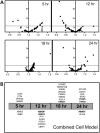Functional consequences of PRPF39 on distant genes and cisplatin sensitivity
- PMID: 22773733
- PMCID: PMC3441128
- DOI: 10.1093/hmg/dds266
Functional consequences of PRPF39 on distant genes and cisplatin sensitivity
Abstract
Variation in gene expression has been found to be important in disease susceptibility and pharmacogenomics. Local and distant expression quantitative trait loci (eQTLs) have been identified via genome-wide association study (GWAS); yet the functional analysis of these variants has been challenging. The aim of this study was to unravel the functional consequence of a gene with a local SNP with evidence for local and distant regulatory roles in cellular sensitivity to cisplatin, one of the most widely used chemotherapeutic drugs. To this end, we measured cellular susceptibility to cisplatin in 176 HapMap lymphoblastoid cell lines derived from Yoruba individuals from Ibadan, Nigeria. The 276 cytotoxicity-associated SNPs at the suggestive threshold of P ≤ 0.0001 were significantly enriched for eQTLs. Of these SNPs, we found one intronic SNP, rs17115814, that had a significant relationship with the expression level of its host gene, PRPF39 (P= 0.0007), and a significant correlation with the expression of over 100 distant transcripts (P ≤ 0.0001). Successful knockdown of PRPF39 expression using siRNA resulted in a significant increase in cisplatin resistance. We then measured the expression of 61 downstream targets after PRPF39 knockdown and found 53 gene targets had significant (P ≤ 0.05) expression changes. Included in the list of genes that significantly changed after PRPF39 knockdown were MAP3K4 and TFPD2, two important signaling genes previously shown to be relevant in cisplatin response. Thus, modulation of a local target gene identified through a GWAS was followed by a downstream cascade of gene expression changes resulting in greater resistance to cisplatin.
Figures





Similar articles
-
Protein quantitative trait loci identify novel candidates modulating cellular response to chemotherapy.PLoS Genet. 2014 Apr 3;10(4):e1004192. doi: 10.1371/journal.pgen.1004192. eCollection 2014 Apr. PLoS Genet. 2014. PMID: 24699359 Free PMC article.
-
Chemotherapeutic-induced apoptosis: a phenotype for pharmacogenomics studies.Pharmacogenet Genomics. 2011 Aug;21(8):476-88. doi: 10.1097/FPC.0b013e3283481967. Pharmacogenet Genomics. 2011. PMID: 21642893 Free PMC article.
-
Genome-wide local ancestry approach identifies genes and variants associated with chemotherapeutic susceptibility in African Americans.PLoS One. 2011;6(7):e21920. doi: 10.1371/journal.pone.0021920. Epub 2011 Jul 6. PLoS One. 2011. PMID: 21755009 Free PMC article.
-
Genetic and epigenetic variants contributing to clofarabine cytotoxicity.Hum Mol Genet. 2013 Oct 1;22(19):4007-20. doi: 10.1093/hmg/ddt240. Epub 2013 May 29. Hum Mol Genet. 2013. PMID: 23720496 Free PMC article.
-
Expression Quantitative Trait Loci Information Improves Predictive Modeling of Disease Relevance of Non-Coding Genetic Variation.PLoS One. 2015 Oct 16;10(10):e0140758. doi: 10.1371/journal.pone.0140758. eCollection 2015. PLoS One. 2015. PMID: 26474488 Free PMC article. Review.
Cited by
-
Hsa‑circRNA‑G004213 promotes cisplatin sensitivity by regulating miR‑513b‑5p/PRPF39 in liver cancer.Mol Med Rep. 2021 Jun;23(6):421. doi: 10.3892/mmr.2021.12060. Epub 2021 Apr 13. Mol Med Rep. 2021. PMID: 33864660 Free PMC article.
-
Generation and characterization of transgene-free human induced pluripotent stem cells and conversion to putative clinical-grade status.Stem Cell Res Ther. 2013 Jul 26;4(4):87. doi: 10.1186/scrt246. Stem Cell Res Ther. 2013. PMID: 23890092 Free PMC article.
-
Regulation of protein-coding gene and long noncoding RNA pairs in liver of conventional and germ-free mice following oral PBDE exposure.PLoS One. 2018 Aug 1;13(8):e0201387. doi: 10.1371/journal.pone.0201387. eCollection 2018. PLoS One. 2018. PMID: 30067809 Free PMC article.
-
Prognostic implications of alternative splicing events and key splicing factors in head and neck squamous cell carcinoma.Discov Oncol. 2025 Mar 31;16(1):430. doi: 10.1007/s12672-025-02214-x. Discov Oncol. 2025. PMID: 40159586 Free PMC article.
-
Pan-drug and drug-specific mechanisms of 5-FU, irinotecan (CPT-11), oxaliplatin, and cisplatin identified by comparison of transcriptomic and cytokine responses of colorectal cancer cells.Oncotarget. 2021 Sep 28;12(20):2006-2021. doi: 10.18632/oncotarget.28075. eCollection 2021 Sep 28. Oncotarget. 2021. PMID: 34611476 Free PMC article.
References
-
- Ross C.J., Katzov-Eckert H., Dube M.P., Brooks B., Rassekh S.R., Barhdadi A., Feroz-Zada Y., Visscher H., Brown A.M., Rieder M.J., et al. Genetic variants in TPMT and COMT are associated with hearing loss in children receiving cisplatin chemotherapy. Nat. Genet. 2009;41:1345–1349. - PubMed
-
- Oldenburg J., Kraggerud S.M., Cvancarova M., Lothe R.A., Fossa S.D. Cisplatin-induced long-term hearing impairment is associated with specific glutathione S-transferase genotypes in testicular cancer survivors. J. Clin. Oncol. 2007;25:708–714. - PubMed
Publication types
MeSH terms
Substances
Grants and funding
LinkOut - more resources
Full Text Sources
Molecular Biology Databases
Miscellaneous

